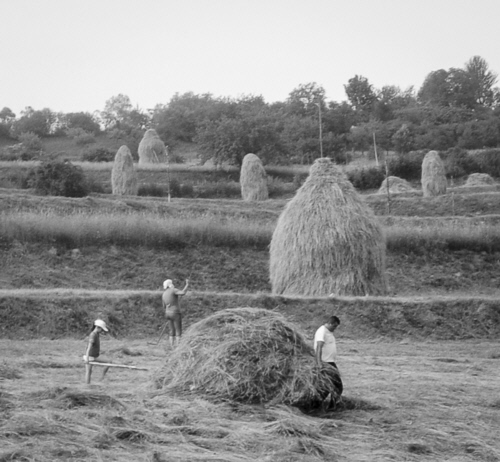When travelling around Maramures near the border with Ukraine, people doing manual work in the meadows and tall, round haystacks are a common sight. Workers, men and women, girls and boys, walking along the road with wooden pitchforks and scythes on their shoulders on hot summer days wearing nothing on their heads to protect themselves from the fierce sun are also commonly seen. Having let industrial agriculture, which has swept across the whole of Western Europe, pass them by they still work as farmers were doing 100 years ago.
The hay is used to feed their horses and cows from late autumn to early spring and it requires huge amounts of work. From mowing the meadows with a scythe to raking the hay into small heaps and turning it around to make it dry to making huge haystacks to filling a cart with hay and bringing it back to the farm is a type of work which most of our great-grandparents had left behind.
Having joined a haymaking course and worked as a volunteer on an overgrown meadow, I can confirm that haymaking is hard work. You have to work on a field with no shade, you need to sharpen your scythe regularly, the ground may be uneven making scything difficult, you may need to scythe or rake upwards, you need to drink water regularly, and preferably take a break occasionally. However, everyone is working towards a common goal, there is no boss such that everyone is equal, everyone works as hard as he/she is capable of. All these factors contribute to that you feel you are a part of a group and your work is appreciated.
As regards the haystacks, they are really big. Before making one, three poles are bound together at one point and the opposite ends are driven into the ground. Then, hay is stacked around the poles such that the height of the haystack may reach heights of 3(?) metres. The workers use ladders to get on top of the haystacks and put even more hay on the top. Being an outsider, it was a beautiful sight to see rows upon rows of haystacks on the meadows, enriching my visual experience. For the locals, it may be something completely different. However, having been haymaking myself, I still think haystacks and hayracks on a freshly mowed meadow look lovely.
Incidentally, the great Dutch artist Pieter Bruegel painted The Corn Harvest in 1565. Judging from this painting, the characters in the painting would have felt at home at haymaking in Maramures.
For those who want to know more, this article is highly recommended.

